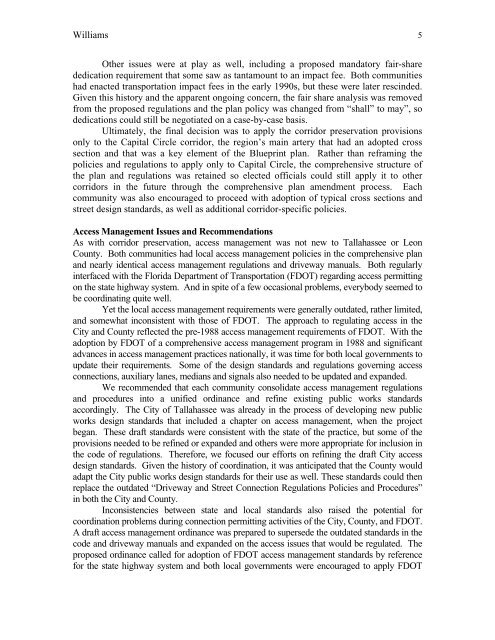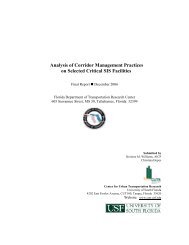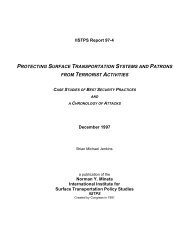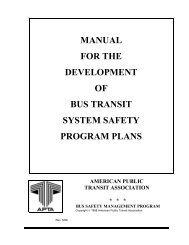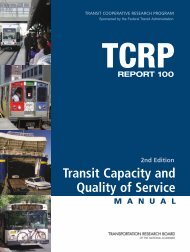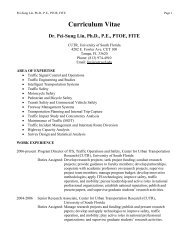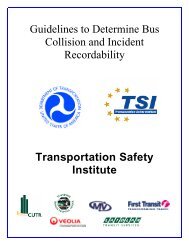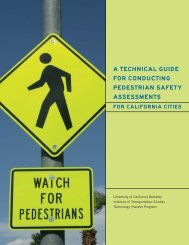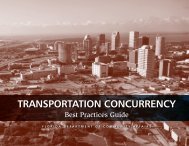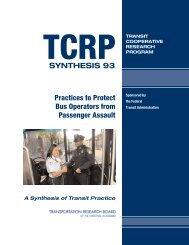Tallahassee-Leon County Corridor Management Program
Tallahassee-Leon County Corridor Management Program
Tallahassee-Leon County Corridor Management Program
You also want an ePaper? Increase the reach of your titles
YUMPU automatically turns print PDFs into web optimized ePapers that Google loves.
Williams 5Other issues were at play as well, including a proposed mandatory fair-sharededication requirement that some saw as tantamount to an impact fee. Both communitieshad enacted transportation impact fees in the early 1990s, but these were later rescinded.Given this history and the apparent ongoing concern, the fair share analysis was removedfrom the proposed regulations and the plan policy was changed from “shall” to may”, sodedications could still be negotiated on a case-by-case basis.Ultimately, the final decision was to apply the corridor preservation provisionsonly to the Capital Circle corridor, the region’s main artery that had an adopted crosssection and that was a key element of the Blueprint plan. Rather than reframing thepolicies and regulations to apply only to Capital Circle, the comprehensive structure ofthe plan and regulations was retained so elected officials could still apply it to othercorridors in the future through the comprehensive plan amendment process. Eachcommunity was also encouraged to proceed with adoption of typical cross sections andstreet design standards, as well as additional corridor-specific policies.Access <strong>Management</strong> Issues and RecommendationsAs with corridor preservation, access management was not new to <strong>Tallahassee</strong> or <strong>Leon</strong><strong>County</strong>. Both communities had local access management policies in the comprehensive planand nearly identical access management regulations and driveway manuals. Both regularlyinterfaced with the Florida Department of Transportation (FDOT) regarding access permittingon the state highway system. And in spite of a few occasional problems, everybody seemed tobe coordinating quite well.Yet the local access management requirements were generally outdated, rather limited,and somewhat inconsistent with those of FDOT. The approach to regulating access in theCity and <strong>County</strong> reflected the pre-1988 access management requirements of FDOT. With theadoption by FDOT of a comprehensive access management program in 1988 and significantadvances in access management practices nationally, it was time for both local governments toupdate their requirements. Some of the design standards and regulations governing accessconnections, auxiliary lanes, medians and signals also needed to be updated and expanded.We recommended that each community consolidate access management regulationsand procedures into a unified ordinance and refine existing public works standardsaccordingly. The City of <strong>Tallahassee</strong> was already in the process of developing new publicworks design standards that included a chapter on access management, when the projectbegan. These draft standards were consistent with the state of the practice, but some of theprovisions needed to be refined or expanded and others were more appropriate for inclusion inthe code of regulations. Therefore, we focused our efforts on refining the draft City accessdesign standards. Given the history of coordination, it was anticipated that the <strong>County</strong> wouldadapt the City public works design standards for their use as well. These standards could thenreplace the outdated “Driveway and Street Connection Regulations Policies and Procedures”in both the City and <strong>County</strong>.Inconsistencies between state and local standards also raised the potential forcoordination problems during connection permitting activities of the City, <strong>County</strong>, and FDOT.A draft access management ordinance was prepared to supersede the outdated standards in thecode and driveway manuals and expanded on the access issues that would be regulated. Theproposed ordinance called for adoption of FDOT access management standards by referencefor the state highway system and both local governments were encouraged to apply FDOT


